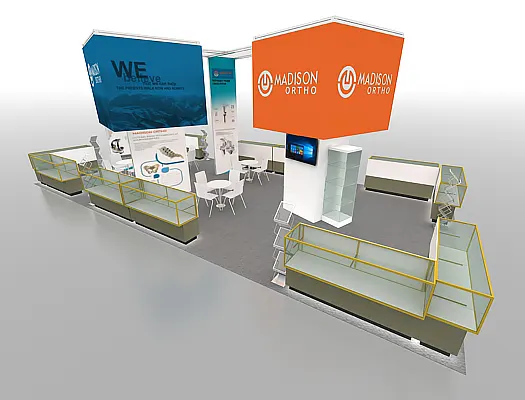
Custom exhibition stand builders play a crucial role in creating impressive visual displays at various trade shows, conferences, and exhibitions. They help companies attract potential customers and generate brand awareness in crowded venues through creatively designed stands.
While custom stands are an important part of event marketing strategies, there are still many surprising facts about the companies that build them:
Designing Stands is as Much an Art as a Science:
Stand builders have to balance functionality, ergonomics, branding needs, and creativity when developing custom designs. They work closely with clients to understand their target audience, key messaging, and budget. Then it’s a complex process of sketching concepts, creating 3D renderings, doing structural planning, and electrical work, and ensuring all elements come together cohesively.
Similar to architects and interior designers, stand builders have to be part designers, engineers, and artists. They need to understand visual hierarchy, flow, branding best practices, lighting effects, and how small details can make a big impact. Designing successful stands requires balancing analytical problem-solving skills with out-of-the-box creative thinking. Exhibition stand manufacturers combine scientific planning with artistic flair to produce visually striking displays their clients love.
Rapid Prototyping Techniques Speed Up the Design-Build Process:
A standard stand project often has very tight deadlines from initial planning to installation at the event venue. To help meet these aggressive timelines, many custom stand builders now leverage advanced manufacturing technologies like 3D printing and CNC machining.
Rapid prototyping allows designers to quickly produce physical models of digital concepts for client reviews. They can test scale, proportions, and assembly feasibility before committing resources to build full-size components. CNC routers precisely cut lightweight materials like PVC pipe and foam board into intricate display elements on demand.
Using these techniques, stand builders can iterate through multiple design iterations in just days or weeks rather than months. Clients see proposals come to life faster and give quicker feedback. Any necessary changes can then be incorporated before fabrication starts, avoiding costly and time-consuming reworks down the road. Rapid prototyping is transforming how exhibit builders develop and refine custom booth designs against tight deadlines.
Building Stands Requires Diverse Skills from Various Trades:
Behind every custom stand is a team that combines talents from woodworking, metal fabrication, electrical work, graphics installation, and project management. Stand builders employ or contract specialists from each of these fields to complete projects.
Carpenters construct the structural frames from wood or aluminum extrusions. Welders craft bespoke display units and mounting hardware from steel and aluminum sheets. Electricians expertly route and hide cabling while meeting electrical codes. Graphics professionals precisely apply printed vinyl, dimensional letters, and digital displays. Logistics experts choreograph the assembly, shipping, and on-site installation process.
Coordinating inputs from such a wide range of professionals takes strong leadership. Trade show booth builders must seamlessly integrate each trade’s work while resolving issues that inevitably arise along the way. Their project management skills are as essential as the technical abilities of their teams.
Custom Stands Involve Surprisingly Complex Engineering:
While stands may look like simple visual backdrops, supporting large graphic panels, lighting elements, and multimedia equipment safely requires sophistication. Stand builders must consider critical engineering factors like:
- Structural load calculations for maximum weight capacities based on materials and expected stress points.
- Stability testing under seismic, wind, transportation vibration, and crowd forces specified by event health and safety codes.
- Rigorous testing and certification of electrical systems to prevent hazards from ground faults or shorts.
- Adherence to rigorous fire safety standards through flame-retardant materials and electrical insulation where needed.
Ensuring stands can withstand real-world rigors without failure is a serious undertaking. For the exhibition stand construction builders rely on the principles of mechanical, civil, and electrical engineering every bit as much as their craftsmanship skills. Their structures undergo rigorous analysis and testing that most people never see.
The Industry Faces Constant Technological Evolution:
From interactive touchscreens to augmented reality, digital experiences are transforming trade show marketing. Stand builders must stay on the cutting edge of new technologies to deliver outstanding interactive and multimedia features their clients demand.
Some leading firms now have in-house programmers and electrical engineers developing customized digital content and apps. Many establish partnerships with AV integration companies to source the latest equipment. Some are even experimenting with virtual and hybrid event platforms to reach audiences beyond physical venues.
Adapting to technological shifts requires continuous training, certifications, and research investments rare in traditional construction fields. For custom exhibition stand suppliers, standing still means falling behind competitors. Their innovation drives the entire industry forward as technology reshapes what’s possible for event experiences.
In Summary-
As this article outlines, custom exhibition stand building involves far more intricacy than what meets the eye. Behind every visually striking display booth are designers balancing art with science, craftspeople with engineering skills, and teams managing complex technology integrations.
Exhibition Stand design companies orchestrate contributions from various specialized trades while evolving constantly to harness innovations. Their ingenuity, technical mastery, and project management prowess make otherwise impossible experiences a reality for event marketers every year. Truly, their impact spans creativity and technology alike.










